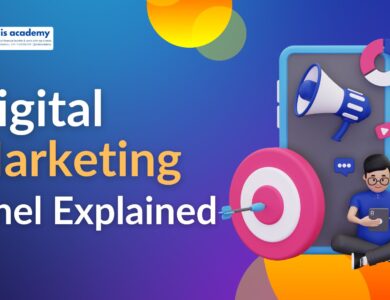Marketing Metrics That Matter: The KPIs You Can’t Afford to Ignore
Discover essential marketing metrics and KPIs that drive growth, optimize performance, and ensure your campaigns deliver measurable, impactful results every time.

In a world where data drives decisions, digital marketers have access to more metrics than ever before. From impressions and click-through rates to conversion paths and customer lifetime value, the sheer volume of available data can be overwhelming.
Yet, while analytics platforms can produce endless dashboards and reports, not all metrics actually help you make better marketing decisions.
Here’s the truth: not all metrics are created equal.
Many businesses unknowingly focus on so-called “vanity metrics” — numbers that look impressive on paper but fail to drive actionable insights. These might include follower counts, likes, or raw traffic numbers that don’t reflect the true performance of your marketing efforts.
In contrast, Key Performance Indicators (KPIs) provide strategic value. They show what’s really driving growth, what needs fixing, and where your budget is actually returning results.
In this guide, we’ll unpack the most critical marketing metrics that matter — the ones you can’t afford to ignore if you want sustainable ROI, higher conversions, and optimized performance.
Also Read: What Is Digital Marketing? Definition, Basics & How It Works
1. Website Traffic – The Gateway Metric (But Not the Destination)
Website traffic is often the first metric new marketers look at. It gives a surface-level idea of how many people are visiting your site, but by itself, it doesn’t tell the full story.
Why it matters:
It’s your starting point. Without traffic, no one is seeing your offers, content, or brand message. But you need to go deeper — into traffic sources, intent, and behavior.
Dig deeper:
- Traffic by source/medium: Are users coming from Google (organic), paid ads, direct links, email, or referrals?
- Device and geography: Where are your users located and how are they browsing?
- Behavior flow: What pages do users visit most, and where do they drop off?
How to act: Use this data to determine which marketing channels are delivering qualified traffic and where you should double down or pivot.
2. Conversion Rate – Measuring Real Success
It’s not enough to bring people to your website — you need them to take action. Whether that’s buying a product, signing up for a newsletter, or filling out a form, your conversion rate reflects how effectively you’re turning interest into impact.
Why it matters:
Conversion rate is arguably the most critical performance metric. It directly links marketing efforts to business outcomes and revenue.
Real-world scenario:
If 1,000 visitors come to your landing page and 25 make a purchase, your conversion rate is 2.5%. Improving this to just 3% could significantly boost your ROI — without increasing your ad spend.
What to test:
- CTA button placement and copy
- Landing page design and messaging
- Page load speed and mobile responsiveness
- Social proof (reviews, testimonials, case studies)
3. Customer Acquisition Cost (CAC) – What Are You Paying to Grow?
Knowing how much it costs to acquire a new customer is essential for budgeting and strategic planning. If you’re spending more to gain a customer than they bring in revenue, you’re scaling at a loss.
Why it matters:
CAC highlights the true cost of growth. When combined with LTV (see below), it gives you a realistic view of profitability.
In-depth insight:
Include all expenses — ad spend, software subscriptions, salaries of your marketing team, tools, consultants — to get a complete picture.
Optimizing CAC:
- Improve targeting to avoid wasting ad budget
- Shorten your sales cycle with better funnel automation
- Nurture leads with high-value email campaigns
Also Read: B2B vs B2C Digital Marketing – Key Strategy Differences Explained
4. Customer Lifetime Value (LTV or CLV) – The Long Game Metric
LTV measures the total revenue a customer brings during their relationship with your brand. It’s especially crucial in subscription-based or service businesses but applies to all models.
Why it matters:
It shows how valuable a customer really is — and how much you can afford to spend to acquire them.
Data-driven growth:
- A business with a high LTV can afford a higher CAC and still profit.
- Retention strategies become more valuable when LTV increases.
Ways to increase LTV:
- Upselling and cross-selling
- Building loyalty programs
- Offering subscription or membership options
5. Return on Ad Spend (ROAS) – Campaign Efficiency at a Glance
If you’re running paid campaigns, ROAS tells you exactly how much revenue is being generated per dollar spent. It’s your go-to metric for measuring ad efficiency.
Why it matters:
It helps you make fast, informed decisions about ad performance and budget allocation.
Pro insight:
Don’t just track ROAS by platform — break it down by ad set, audience, creative, and even placements. You might find that Instagram Stories have double the ROAS of Facebook Feed ads.
Improve ROAS by:
- Testing different ad creatives
- Refining your audience targeting
- Optimizing landing pages for conversions
6. Email Marketing Metrics – Gauging Your Direct Channel
Email marketing remains a powerful tool, especially for nurturing leads and boosting retention. But to make it work, you need to monitor the right KPIs.
Key metrics to track:
- Open Rate: Measures subject line effectiveness and sender reputation
- Click-Through Rate (CTR): Measures how compelling your content is
- Conversion Rate: Ties engagement to action (e.g., purchases)
- Unsubscribe/Bounce Rates: Reveal list quality and campaign fatigue
Pro tip: Segment your email list and personalize content to boost engagement. Use A/B testing on subject lines, send times, and CTAs.
Also Read: 10 Common Digital Marketing Myths You Need to Stop Believing
7. Social Media Engagement Rate – More Than Just Likes
Engagement rate shows how actively your audience is interacting with your content — and whether your messaging is resonating.
Why it matters:
Algorithms reward high engagement. More likes, comments, and shares mean more visibility.
Deep insight:
Don’t fall into the trap of equating followers with success. It’s better to have 1,000 engaged followers than 10,000 passive ones.
Improve engagement by:
- Posting consistently
- Using interactive formats (polls, Q&As, live video)
- Encouraging user-generated content
8. Bounce Rate and Time on Site – Understanding User Behavior
Bounce rate reflects the percentage of visitors who leave your site without interacting. Time on site indicates how engaging your content or user journey is.
Why it matters:
Together, these metrics help you understand whether your site matches user expectations.
What high bounce rates can indicate:
- Poor landing page experience
- Irrelevant traffic
- Slow loading speed
How to fix:
- Improve UX and mobile responsiveness
- Optimize page speed
- Align content with user intent
9. Lead-to-Customer Conversion Rate – The Funnel Health Metric
Tracking how many leads actually convert into paying customers is essential for evaluating your sales funnel and marketing-to-sales alignment.
Why it matters:
It identifies weak points in your nurturing sequence or qualification process.
Improve by:
- Providing sales enablement content (e.g., case studies, FAQs)
- Using lead scoring to prioritize high-intent leads
- Implementing retargeting and email drips
10. Net Promoter Score (NPS) – The Loyalty Signal
NPS isn’t about campaign performance — it’s about brand sentiment. It shows how likely your customers are to recommend you to others.
Why it matters:
Referrals are one of the most cost-effective customer acquisition methods.
Insightful actions:
- Use detractor feedback to refine onboarding and product experience
- Turn promoters into brand ambassadors via referral programs
Also Read: History of Digital Marketing – How It All Began and Where It’s Headed
Conclusion: Focus on What Moves the Needle
You don’t need to track every metric. You need to track the right ones — those that align with your business model, funnel stage, and revenue goals.
Use KPIs not just to report, but to learn, optimize, and grow. Let them guide your decisions, refine your strategies, and spotlight where the real opportunities lie.
Because at the end of the day, marketing isn’t about data overload — it’s about data-driven clarity.





